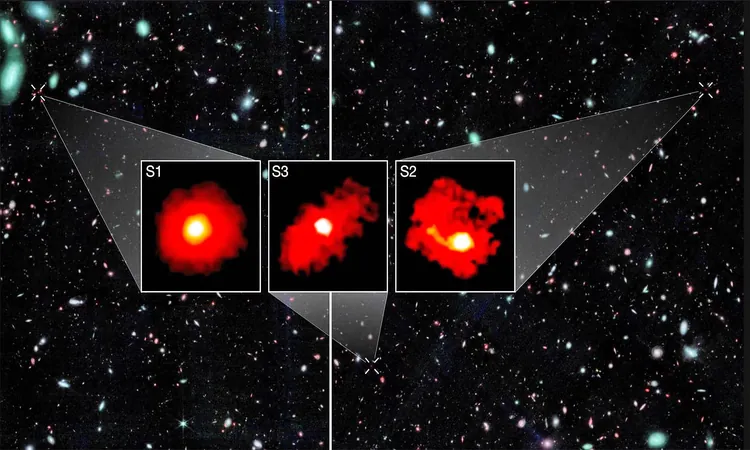
Revelation in Space: Three 'Red Monsters' Discovered, Signaling a New Era in Astronomy!
2025-05-04
Author: Wai
When the Webb Telescope unveiled its initial deep-field images, astronomers anticipated a subtle stream of distant, fledgling galaxies. Instead, they were astounded to discover radiant, massive "red monster" galaxies, shining brightly just 500 million to one billion years after the Big Bang.
This unexpected cosmic explosion of redshifted galaxies caught even veteran researchers off guard, challenging their established understanding of galaxy evolution.
These colossal galaxies, some boasting masses comparable to today’s Milky Way, challenge the conventional Lambda Cold Dark Matter (ΛCDM) model. If such giants emerged so early in cosmic history, perhaps the timeline for star formation needs a serious reevaluation.
A Deep Dive into Cosmic Mysteries
To understand what the Webb Telescope had uncovered, an international team investigated the FRESCO survey, which combines sharp imaging with spectroscopic data to determine galaxies' distances and ages.
After examining 36 dusty galaxies, the researchers found that while most adhered to the ΛCDM framework, three stood out dramatically. Each of these galaxies has a stellar mass exceeding 10 billion times that of the Sun—an astounding feat for the universe's first billion years.
Collectively, these galaxies contributed to about 17 percent of all star formation during the redshift periods 5 and 6, when the universe was still in its infancy.
Revolutionizing Our Understanding of Early Galaxy Formation
Dr. Mengyuan Xiao, the study's lead author from the University of Geneva, stated, “Our findings are reshaping our understanding of galaxy formation in the early universe.” The efficiency of these three galaxies is particularly striking; they converted nearly half of the available normal matter within their dark matter halos into stars—roughly two to three times the star formation rate seen in later cosmic eras.
While typical galaxies manage only 20 percent, the light emitted from these early titans suggests that they owe their star-forming capability not to a ravenous central black hole but rather to their sheer size and gas density.
The 'Red Monster' Phenomenon Unveiled
Known as 'red monsters' due to their high dust content, these galaxies appear red in the near-infrared view captured by the Webb Telescope.
Dr. David Elbaz from CEA Paris-Saclay noted that these massive properties were virtually invisible to previous telescopes limited to ultraviolet light, which dust readily absorbs.
The innovative NIRCam/grism setup of Webb revolutionizes our ability to detect the faint light of star-forming areas, even when obscured by cosmic dust.
Changing Cosmic Narratives
Traditional models suggest that dark matter halos provide the framework for gas to cool and form stars over billions of years. Most galaxies struggle to transform more than a fifth of their gas into stars.
However, the red monsters defy these expectations by forming stars at nearly double the efficiency of their smaller counterparts. This revelation implies that the conditions in the young universe—potentially higher densities, faster cooling rates, or more frequent mergers—allowed rapid growth.
Dr. Xiao concludes, “These results indicate that galaxies in the early universe could form stars with unexpected efficiency, paving the way for a new understanding.”
What's Next for Astronomy?
The implications of discovering these red monsters are profound. As light travels through space, Webb allows us to glimpse the universe as it existed 13 billion years ago.
The existence of such massive galaxies shortly after the Big Bang compels theorists to reexamine the foundational elements of their simulations. Did early gas clouds cool more quickly? Were primordial stars responsible for seeding galaxies with heavier elements sooner than previously anticipated? Or do current models underestimate how efficiently matter gathers in high-redshift scenarios?
Future Webb initiatives aim to expand our catalog of early massive systems, while tools like the Atacama Large Millimeter/submillimeter Array (ALMA) will delve deeper into the cold gas and dust structures.
As more red monsters are identified, it may unlock additional secrets about star formation and cosmic evolution during one of the universe's most turbulent epochs.
For now, this trio of red giants serves as a testament to the cosmos's many hidden wonders, affirming that as astronomers explore further, they are bound to uncover a universe that was far more dynamic—and efficient—than anyone dared to imagine.



 Brasil (PT)
Brasil (PT)
 Canada (EN)
Canada (EN)
 Chile (ES)
Chile (ES)
 Česko (CS)
Česko (CS)
 대한민국 (KO)
대한민국 (KO)
 España (ES)
España (ES)
 France (FR)
France (FR)
 Hong Kong (EN)
Hong Kong (EN)
 Italia (IT)
Italia (IT)
 日本 (JA)
日本 (JA)
 Magyarország (HU)
Magyarország (HU)
 Norge (NO)
Norge (NO)
 Polska (PL)
Polska (PL)
 Schweiz (DE)
Schweiz (DE)
 Singapore (EN)
Singapore (EN)
 Sverige (SV)
Sverige (SV)
 Suomi (FI)
Suomi (FI)
 Türkiye (TR)
Türkiye (TR)
 الإمارات العربية المتحدة (AR)
الإمارات العربية المتحدة (AR)